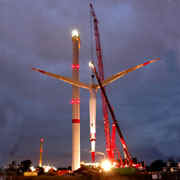 |
Two-loop windmill for stable energy supply Project substantiation p. 2 |
 |
As wind-power engineering develops, windmills gain versatile constructions; above usual constructions with horizontal axis, there are now many constructions with that vertical. In particular, the roundabout-type construction (see Fig. 6a) relates to them. Such construction is able to work when weak wind: ōIn the weak-wind regions, only slow low-revolution windmills are active. One of the versions of low-revolution windmill is with the vertical axis, so-called roundabout-type. Such windmills can give nominal parameters at the speed of wind from 2-4 m/s, while winged windmills with horizontal axis require higher speed of wind and achieve nominal parameters from 8-12 m/sö [10]. No less interesting is the construction like Archimedean screw used by A. Abushenko (Fig. 6b) as Czech specialists do, where ōminiature windmills are autonomous aerators, they pump air under water lest fishes sleep and eat betterö [11].
|
a |
b |
Fig. 6 |
The parallel development of constructions with horizontal and vertical axes takes place in engineering of powerful windmills also. We would mark such horizontal-axis constructions as shown in Fig. 7a; it has been mounted by the largest company NEG Micon whose headquarter is in Denmark [6] and the largest windmill mounted by REpower Systems AG as a joint project of ōEU Commission and German land Schleswig-Holstein. The giant three-bladed rotor has risen over the earth on the tower more than 180 meters in height. The mill was named REpower 5M, which means its power ¢ 5 Megawatt. It is the most powerful windmill in the worldģ Interestingly that this company has already mounted in Germany a bit smaller windmills that also were greatest in the world ¢ with the rotors of 70 and 82 meters in diameter and 1,5 and 2 Megawatts in powerö [12, see Fig. 7b]. In Fig. 7 we show two moments when these mills were mounted.
|
a |
 b |
Fig. 7
|
|
A separate trend of horizontal-axis windmills development are rotor windmills shown in Fig. 8 (a ¢ in the village Yankovtsy, b ¢ in Minsk district). The authors evaluate ōthe practically usable wind potential in Belarus is 300¢400 milliards of kW*hour per year. The difficulty is, contemporary widely used in the world bladed <windmills work unstably and inefficiently at> low speeds of wind typical for Belarus (just as for any continental part of the Earth) and cost much. The Ltd Aerolla has developed a rotor windmill VEU. Its wind turbine is rotor-type, based on the known Magnus effect. The research conducted by Ltd Aerolla in this trend showed that they succeeded to raise the efficiency of such turbine 2¢3 times in comparison with those bladedö [13].
|
a |
 b |
Fig. 8
|
|
None the less, rotor turbines, with all its merits before bladed ones, have a significant demerit ¢ low power under weak wind flows. The authors of [13] give data concerning the AerollaÆs turbine which they show in the Table 1; they say, their turbine achieves the designed power at the speed of wind about 6 m/s.
|
Table 1. The calculation of power and yearly productivity of the Aerolla windmill
|
||||||||||||||||||||||||||||||||||||||||||||||||||||||||||||||||||||||||||||||||||||||||||||||||||||||||||||||||||||||||||||||||||
Symbols in the table: ą1 i is the power of wind flow through 1 meter of the flowed-about surface made by the wind with the speed Vi, ąS i is the power of wind flow over the whole flowed-about surface, ą¾±“ , is the power of windmill, ┼i is the energy produced by the windmill at the speed of wind Vi, given its yearly repeatability, coefficients of use of power of the wind flow for rotor-type VEU and their established power. However, the most typical for that place values of wind load are lower than 6 m/s, and during only one fifth part of a year the wind is faster than 3 m/s. Given the whole time when the wind is faster than 3 m/s is about 59 % of usual year, the whole time when the turbine works lower its designed power is about 66,4 % of the usual year. Such efficiency is quite low of course, especially if we account that the turbine uses flows having speed more than 6 m/s with the efficiency that sufficiently lessens with the growing speed of flow (because of the requirement to stabilise the generated strength). If the characteristics of a rotor turbine are trice higher, as the authors calculated, we can surely say of even less efficiency of bladed windmills at low wind speeds typical for most of flat countries. And this is corroborated by data of company NEG Micon. According to their Table 2 [6], a windmill starts working only at 2-4 m/s and achieves the nominal regime at 16 m/s. Comparing with the distribution of yearly wind load in the Table 1, we can really expect the low efficiency of blade windmills at low speeds of average wind load |
|
Table 2
|
||||||||||||||||||||||||
We should mark that at speeds of wind higher than that nominal, utilisation factor of bladed windmills falls also, because the delivered power is regulated. Maybe by this reason the company NEG Micon builds windmills in seas where the intensity of flows is higher and turbulence lower, the flows are more stable than on the beach. |
--------------------------------------
Journal of laboratory Business-plan Substantiation of project